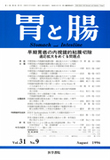Japanese
English
- 有料閲覧
- Abstract 文献概要
- 1ページ目 Look Inside
要旨 患者は50歳の女性で,胃前庭部前壁に3mmのⅡcが発見された.生検診断は中分化型腺癌(tub2)であった.根治目的でEMRが行われ,完全切除が得られたと考えられた.しかし,EMRの組織診断ではⅡcに連続して低分化腺癌(por)の粘膜内浸潤がみられ断端陽性であった.幽門側胃切除が行われた.切除胃の組織学的所見では,EMR潰瘍の前壁側に27×25mmのⅡb(por)の残存が認められた.低分化腺癌は術前に病変の範囲を正確に診断することが困難であることが少なくなく,根治目的としたEMRの絶対的適応にはすべきでないと考えられる.
A 50-year-old female was admitted to our hospital with complaints of epigastralgia. Endoscopy revealed early gastric cancer (type Ⅱc), 3 mm in diameter at the anterior wall of the antrum (Fig. 1). Histologically, it was moderately differentiated adenocarcinoma. No invasive cancer was diagnosed by x-ray and endoscopy. Endoscopic mucosal resection (EMR) was performed as a curative therapy. The resected material was 37 × 26 mm in size. Immediately after EMR it was considered that this lesion had been completely resected. However, afterwards, we judged this therapy as non-curative because histologically, poorly differentiated adenocarcinoma had invaded close to the cutends of the EMR specimens (Fig. 6) . A distal gastrectomy was performed. Macroscopically, the remains of cancer cells were not apparent around the EMR induced ulcer. Histologically, cancer cells remained extensively in the lamina propria of the mucosa on the anterior side of the artificial ulcer (Fig. 9 a, b) . This lesion had not been accurately diagnosed before EMR because cancer cells did not invade the epithelium of the mucosa. At present, we don't regard EMR in a patient with an undifferentiated carcinoma as a definitively curative therapy because, as in our patient, it is sometimes difficult to identify accurately the margins of the lesion.

Copyright © 1996, Igaku-Shoin Ltd. All rights reserved.


